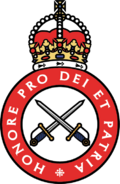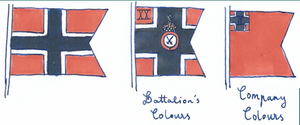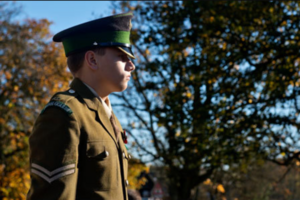King's Cadet Corps: Difference between revisions
| Line 71: | Line 71: | ||
==Membership== | ==Membership== | ||
[[File:GNCadet2.png|thumbnail|right|A cadet corporal from 51 Coy. Huttingfield, 25 Bn., on parade.]]Membership of the Corps as a cadet is open to boys of good repute between the ages of | [[File:GNCadet2.png|thumbnail|right|A cadet corporal from 51 Coy. Huttingfield, 25 Bn., on parade.]]Membership of the Corps as a cadet is open to boys of good repute between the ages of 10 and 18 inclusive, although the vast majority of boys join before the age of 13. Cadets must be of the [[Church of Nortend]] and of satisfactory physical ability. In 2019, there were 660,888 cadets in the Corps and around 5,000 adult staff officers. Girls may not become cadets. Boys typically join the Corps when they enter the First Form in [[Education in Great Nortend#Senior|senior school]]. Boys join their local company, and normally are allocated to a troop consisting of those living in the same area. Usually, there is a junior troop and a senior troop for a given locality. Boys advance to the senior troop upon entering the Lower Fifth Form year, becoming Able Cadets. | ||
Approximately 70 per cent of boys between the ages of | Approximately 70 per cent of boys between the ages of 10 and 16 are cadets. Even upon leaving senior school after the Fifth Form, over 50 per cent of cadets continue their membership in the corps, up to the age of 18 inclusive, whereupon they become liable for [[Royal Army (Great Nortend)#Muster|muster service]]. | ||
The connexions developed between cadet companies and local regiments and naval bases are considered valuable for volunteer recruitment purposes. It has been estimated that 85% of voluntary enlistees in the Royal Army and Navy Royal have a background as a cadet NCO or higher. Senior cadets who reached the rank of Cadet Under Officer are often eligible to serve as an officer during their [[Royal_Army_(Great_Nortend)#Muster|muster service]]. If so, they may be then commissioned as reserve officers in the Home reserves, and may optionally join the Cadet Corps as staff officers. | The connexions developed between cadet companies and local regiments and naval bases are considered valuable for volunteer recruitment purposes. It has been estimated that 85% of voluntary enlistees in the Royal Army and Navy Royal have a background as a cadet NCO or higher. Senior cadets who reached the rank of Cadet Under Officer are often eligible to serve as an officer during their [[Royal_Army_(Great_Nortend)#Muster|muster service]]. If so, they may be then commissioned as reserve officers in the Home reserves, and may optionally join the Cadet Corps as staff officers. | ||
Revision as of 15:51, 1 January 2021
| His Majesty's Corps of Boy Cadets | |
|---|---|
 Badge of the Cadet Corps | |
| Active | June 5, 1876–present |
| Type | Patriotic youth organisation |
| Size | 864,000 (2019) |
| Headquarters | Lendert-with-Cadell, |
| Motto(s) | Honore pro Dei et Patria |
| Commanders | |
| Captain-General and Admiral | Alexander II |
| Master of Cadets | Maj. Gen. Sir Henry de Wegg-Wainright |
| Insignia | |
| Cadet Cross | |
| Cadet Red Ensign | |
His Majesty's Corps of Boy Cadets, commonly known as the King's Cadet Corps (or the Royal Cadet Corps when there is no king), is a youth organisation operating in Great Nortend. The Corps is run by the Board of Education and the War Office in conjunction with the Home Service, Royal Army, the Navy Royal, the Royal Servicemen's Club and the Erbonian Navy League.
It developed from 19th century volunteer companies of cadets raised in Erbonian independent schools as preparation for commission into the armed forces, with the support of the War Office. In the 20th century, the Board of Education raised companies out of the boys in state senior schools. In 1953, for the Golden Jubilee of Edmund IX, the Corps was formally established by Royal charter, combining the Cadet Training Force, the Sea Cadet Corps, and numerous other small youth groups who voluntarily joined up. Successive monarchs since have served as Captain-General and Admiral of Cadets.
The Corps is a quasi-military organisation. However, it is often described as being “Scouting in a military uniform”, having incorporated much of the fledgling scout associations at its establishment. It is by far the most popular youth organisation for boys. As of the start of 2019, there are 864,000 boys between the ages of 11 and 18 inclusive in the Corps, approximately 73 per cent of all senior school boys.
Symbols
—King Edmund IX, 1953
The objective of the Corps, as stated in its Royal charter and reiterated by Edmund IX at the parade to mark the formation of the Corps in 1953, is to “advance with honour amongst the Boys of Our Realm in youthful camaraderie and Christian manliness, courage, discipline, obedience, reverence, patriotism and solemn and unyielding allegiance to God and the Fatherland”.
The motto, Honore pro Dei et Patria, is Latin for 'By honour for God and the Fatherland', was chosen by Col. Sir Richard Errol, 5th Bart., the then Colonel of Cadets and first Master of Cadets in 1953. The badge of the Corps depicts the crossed swords of the Royal Army and Navy Royal encircled in a band bearing the motto, surmounted by the royal crown.
Members of the Corps normally use the War Cross with a triangular cut out as their flag, rather than the civilian Great Cross, in addition to ceremonial banners, pennants, guidons and standards.
Organisation
The Cadet Corps is formed as a youth corps in the Home Service, although it is not formally part of it. The Corps is headed by the Sovereign, who holds the title of Captain-General and Admiral of the Corps. Operational command of the entire Corps is held by the Master of Cadets, currently Maj. Gen. Sir Stephen Daldey. He is assited by the Colonel of Cadets, Col. Stephen Daldey, representing the Army, and the Commodore of Cadets, Cdr. Henry Polstave, representing the Navy.
Structure
| Corps (864,000 | |||||||||
| Province (160,000—400,000) | |||||||||
| Battalion (10,000–20,000) | |||||||||
| District (1,000–2,000) | |||||||||
| Company (160–240) | |||||||||
| Troop (40–60) | |||||||||
| Patrol (10–15) | |||||||||
The Corps operate on a practical level more locally within a regional and national hierarchy. Local cadet companies of around 200 boys are commanded by adult staff officers, although mostly run by senior cadets. Staff officers of the Corps are commissioned officers in the Home Service. The naming convention is the form 1 Coy. Somewhereton, 2 Ct. Bn. &c. Cadet companies are numbered consecutively through the districts in each battalion.
Within a company, there are usually around four troops. A troop is commanded by a senior Under Officer. A Serjeant is the second-in-command of the troop, with four patrols commanded by Corporals and Lancepersades of around 8 to 12 cadets each. Warranted Officers hold appointments within the company, such as Company Serjeant and Quartermaster. Staff ensigns and lieutenants command the company.
The majority of companies are raised within a senior school, although they are not usually school-run programmes per se except for the units raised in independent schools. That is to say, they draw their members from senior school pupils. Most senior schools, by virtue of their size are covered by multiple companies corresponding to a different portion of the school catchment area. Boarding schools usually have their own independent companies.
Around eight companies are grouped into local districts of around 1,000 to 2,000 cadets commanded by a Captain. A district operates in around a hundred, depending on population. Around ten such districts are grouped into one of the fifty-four roughly county-sized battalions, commanded by a Major. These correspond each to a county, plus four extra for north, east, south and west Greater Lendert. There are three provinces corresponding to the three civil provinces of Great Nortend, each commanded by a Lieutenant-Colonel.
Instruction
Themes
The cadet curriculum is focussed on military, physical and moral instruction. Instruction, planning and leadership is undertaken principally by senior cadets with little to no input from adult staff officers. Adult officers generally are more focussed on the administrative side of operations, as well as supervising any potentially dangerous activities such as shooting.
The precise programme of activities is decided upon on a company, troop or even patrol level; however, many activities are based on general outdoormanship or general military training. This includes learning the history, customs and traditions of the military and the Corps, drill and bearing, navigation (on land or at sea), marksmanship and other military skills, general field-craft or seamanship, and field surgery. Most companies also have military bands and some have horse contingents.
Cadets also participate in physical training in regular cross-country hikes, runs and marches. Apart from land or field activities, troops may also participate in aquatic activities such as rowing, sailing and canoeing. Athletics, swimming, gymnastics, wrestling, sports and games are common weekly activities.
On a moral level, the Corps places emphasis on patriotism. Singing marches and other songs is popular, for instance. Furthermore, loyalty to God, King and country is paramount, followed by loyalty to one's comrades, family and community. This is achieved through obedience to superiors and the hierarchy of rank. Despite this, camaraderie and even a equality between boys of all classes and backgrounds is promoted, subject to the overriding considerations of rank. Religious observance is promoted by the Corps, including evening and morning prayers and regular church parades. Cadets frequently participate in alms drives, to collect money, food and items for the deserving poor.
Activities
All cadet troops have parade nights at least once a week for instruction, exercise and socialisation. Other regular activities are also common, such as day-marches every month and bivouacs every term. Most such activities are undertaken in individual troops and patrols. Each cadet company is also expected to run at least one annual week-long camp in addition to the regular marches and bivouacs. Usually these are held in the spring and summer and including instruction and recreation. Formal parades are conducted throughout the year, especially on Whitsunday, Remembrance Day and on St. George's Day (the patron saint of soldiers) or St. Elmo's Day (the patron saint of sailors). Additionally, most companies hold a formal dinner several times annually.
Membership
Membership of the Corps as a cadet is open to boys of good repute between the ages of 10 and 18 inclusive, although the vast majority of boys join before the age of 13. Cadets must be of the Church of Nortend and of satisfactory physical ability. In 2019, there were 660,888 cadets in the Corps and around 5,000 adult staff officers. Girls may not become cadets. Boys typically join the Corps when they enter the First Form in senior school. Boys join their local company, and normally are allocated to a troop consisting of those living in the same area. Usually, there is a junior troop and a senior troop for a given locality. Boys advance to the senior troop upon entering the Lower Fifth Form year, becoming Able Cadets.
Approximately 70 per cent of boys between the ages of 10 and 16 are cadets. Even upon leaving senior school after the Fifth Form, over 50 per cent of cadets continue their membership in the corps, up to the age of 18 inclusive, whereupon they become liable for muster service.
The connexions developed between cadet companies and local regiments and naval bases are considered valuable for volunteer recruitment purposes. It has been estimated that 85% of voluntary enlistees in the Royal Army and Navy Royal have a background as a cadet NCO or higher. Senior cadets who reached the rank of Cadet Under Officer are often eligible to serve as an officer during their muster service. If so, they may be then commissioned as reserve officers in the Home reserves, and may optionally join the Cadet Corps as staff officers.
Oath
Joining the Corps requires that prospective cadets take the Oath of Engagement in the form prescribed, with [Cadet] replaced as appropriate.
I, A. B., shall be a true and faithful Servant unto His Majesty Our Sovereign Lord as a [Cadet] in His Majesty's Corps of Boy Cadets. So help me God.
Cadet Ranks
The Corps uses a system of rank similar to those of the Royal Army and to a lesser extent, the Navy Royal. The prefix Cadet is not normally used internally, except for the ranks of “Cadet” and “Able Cadet”. There is no equivalent to the rank of Besign or Landman.
| Insignia | (No insignia) | 
|

|
(No insignia) | ||
| Rank | Cadet | Able Cadet | Cadet Corporal | Cadet Serjeant | Cadet Warranted Officer | Cadet Under Officer |
| Abbreviation | Ct. | A. Ct. | Ct. Cpl. | Ct. Sjt. | Ct. W. O. | Ct. U. O. |
Cadet Under Officers receive warrants from the War Office entitling them to be saluted by lower ranking cadets only. Waranted officers receive warrants of appointment, but they are not thereby entitled to salutes. All cadet petty and under officers receive formal training at district or battalion-level training camps. Though they are guided as to what to teach the cadets under their charge, company and troop officers have a high degree of freedom and flexibility.
Staff Officers

Staff officers are regularly commissioned officers of the Home Service, who have been assigned to or have chosen to serve in the Cadet Corps. They are saluted in the normal fashion. Many company and district level schoolmasters are staff officers in the Cadet Corps. Staff officers at battalion level and above are employed full time in the Home Service.
Remuneration
Cadets do not generally receive a wage or salary for their membership in the Corps. Companies receive limited allowances for training expences, certain equipment, and transport only. Cadets are required to pay a shilling a month in fees, in addition to any extra fees for unit training and activities. Certain senior cadets shewing especial zeal may receive small stipends similar to adult officer stipends in the Home Service.
Publications
The Corps produces a monthly magazine, entitled The Boy Cadet which contains news about cadet activities, stories and instruction in all aspects, such as patriotism, military, outdoors and health, as well as general news, politics, history, science, travel reports, reviews, guides, comic strips and advertisements. It is aimed at a wide readership of both junior and senior cadets.
It also produces manuals for cadets, such as the Cadet's Service Handbook, which is a large, 400-page book which is issued to every cadet and details the entire body of practical knowledge a cadet is expected to know, as well as history, regulations and songs. It is also used to record a cadet's details of training and progression.
Uniforms
The duty uniform includes a khaki-tan shirt-blouse with black linen short necktie. This is worn with grey or navy shorts and knee-socks with the black leather belt. A khaki-brown coat is worn over the shirt-blouse in winter, in cold weather and on semi-formal occasions. A grey bonnet cap is worn as headdress, or optionally, a sennit hat in the summer.
Cadets are required to wear the uniform of the Corps in accordance with the Corps' uniform regulations. It should not be worn in conjunction with civilian items of clothing, and must be worn at all times at cadet events and activities, unless explicitly dispensed with. Curved royal blue shoulder patches are sewn onto uniform shirts and coats with the words 'Cadet Corps' embroidered in white. A triangular patch underneath lists the district name and company number, with any sleeve rank insignia underneath.
Cadet NCOs wear lanyards with whistles in accordance with their rank. Senior cadet officers wear the Sam Browne belt with their cadet uniform, as well as shoulder straps. Staff officers wear their appropriate Home Service uniforms, with the cadet shoulder patches or armband (if part-time).
Dress uniforms
Senior cadets and officers are scaled to receive formal uniforms for formal occasions, as well as mess dress. Individual companies may purchase additional uniform items for junior cadets.
This page is written in Erbonian English, which has its own spelling conventions (colour, travelled, centre, realise, instal, sobre, shew, artefact), and some terms that are used in it may be different or absent from other varieties of English. |






